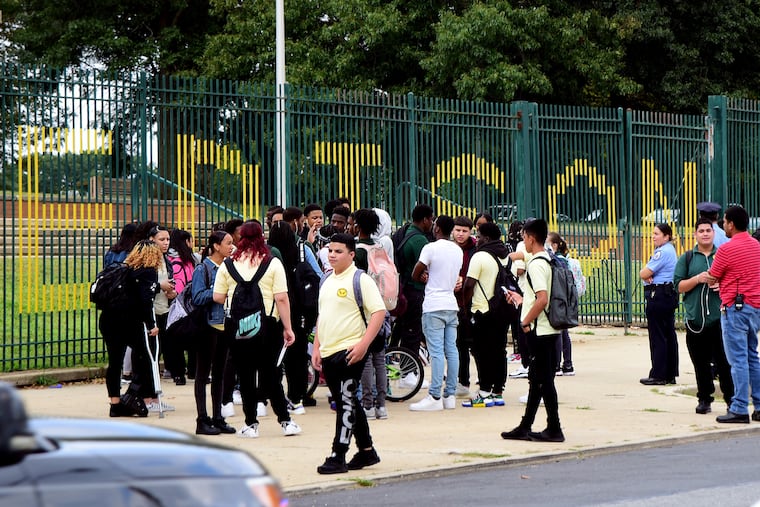Philly’s kids can’t succeed in school if they’re not showing up to class | Editorial
Chronic absenteeism isn’t entirely the Philadelphia School District’s fault. But the district can and must do more to address the problem.

If it’s true that 80% of success is showing up, we can add that to the list of reasons why so many Philadelphia public school students are struggling.
An Inquirer analysis found that nearly half of the students in the Philadelphia School District are “chronically absent,” meaning they missed more than 18 days or 10% of the school year.
The School District has long been plagued by poor attendance, but the percentage of students missing from class has increased since the pandemic. Skipping school leaves students further behind, increases dropout rates, and results in more students graduating with empty diplomas.
Philadelphia is not alone. Nationwide, the number of students considered chronically absent doubled since the pandemic to around 16 million, according to the research group Attendance Works.
There are many reasons why students miss school. In Philadelphia, absenteeism is especially acute for Black and brown students living in poverty, confronting safety fears, mental health issues, and upheaval caused by the pandemic. Some students work, care for younger siblings or elderly family members, move from home to home, or are homeless.
» READ MORE: Philadelphia students deserve safe schools | Editorial
As such, the chronic absenteeism isn’t entirely the School District’s fault. However, the district can and must do more to address the problem. That begins with being open and honest about what is a clear crisis.
The Inquirer engaged in a three-year legal battle to get the data from the district used to create the school-by-school analysis. Hiding the information did not make the problem go away. In fact, it prevented the district from engaging parents, guardians, and the broader community in addressing a problem that negatively impacts student outcomes, and could over time increase the number of undereducated Philadelphians.
To his credit, Superintendent Tony B. Watlington Sr., who started last June, has made attendance a cornerstone of his overall plan to improve the district. He made the stakes clear at a recent school board meeting: “Attending school is a life-and-death issue for many children of color in this city,” he said.
That is not hyperbole. At least 25 Philadelphia public school students have died this year, and 165 have been victims of gun violence.
And here in the nation’s poorest large city, the thousands of students who don’t show up for class risk falling further behind, and will have little prospect of attending college or getting a job that pays more than minimum wage.
That’s even more reason why boosting attendance should be a focus of everyone in the district. While some school principals make engaging students a priority, other schools have a cavalier approach to whether students are in class or not.
A sophomore at George Washington High told The Inquirer that teachers make little effort to keep kids in class: “They just see you leaving, and they don’t care. They say, ‘If you leave, don’t come back in.’ I go to school, and I just leave.”
The Inquirer detailed instances of students who roam the halls all day, while others walk out of class and never return. A separate Inquirer story in November detailed constant chaos at one high school, including frequent fights and the smell of marijuana wafting through the building.
» READ MORE: Mayoral candidates need real plans to fix the city’s troubled schools | Editorial
Such a permissive culture signals to students that school doesn’t matter. At the same time, the district has experienced a sharp increase in teachers quitting and being absent, leading to more turnover, frequent substitutes, and staffing shortages. The lack of stability makes it easier for students to lose interest.
Indeed, at the high school level, 63% of students were chronically absent. At seven high schools, a whopping 90% or more of the students were frequently missing class.
Some school districts have gotten creative about trying to keep kids in school. Pittsburgh sends caregivers letters showing the number of days a student has missed, as well as texts offering resources for help. Colorado and Nevada reduced absenteeism by extending the time breakfast was available for students who did not get to school before the day began. A school in Phoenix implemented a combination of increased communications and outreach as well as publishing attendance numbers to better incentivize parents and students.
The new superintendent in the Los Angeles Unified School District deployed “armies” of administrators and other staffers to knock on doors and find out why kids were missing school. The district then worked with families to address the range of problems, such as housing instability, food insecurity, violence concerns, and lack of transportation. In one year, Los Angeles reduced chronic absenteeism from 43% to 32%.
Watlington can draw on those successes as a source of hope and inspiration for Philadelphia. But ultimately, the district must show up for its students if it wants them to do the same.